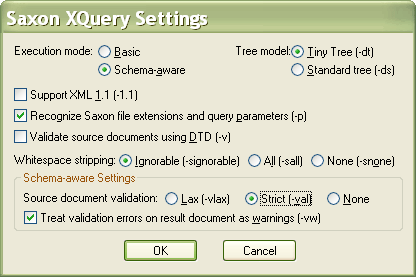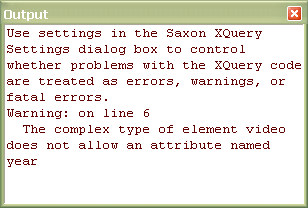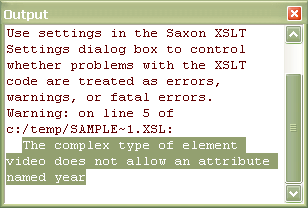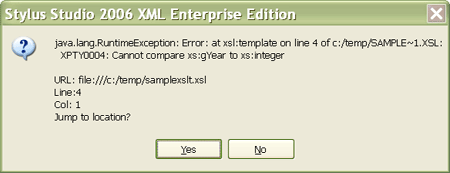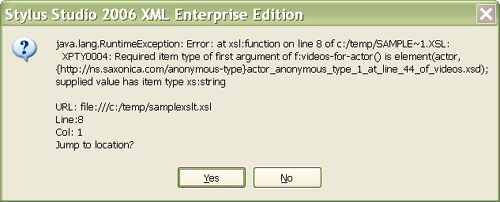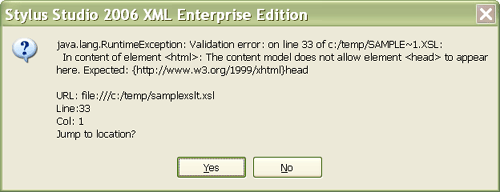|
Home > Learn XML > XML Tutorials > XQuery Tutorials > Schema-Aware Queries and Stylesheets
XQuery Tutorials
Schema-Aware Queries and StylesheetsBy: Dr. Michael Kay In the previous articles in this series I gave a basic introduction to XQuery and a more detailed overview of what you can achieve using XQuery FLWOR expressions. One of the most significant new features in the Stylus Studio 2006 edition is the introduction of support for handling schema-aware XSLT and XQuery. So in this article, that's going to be my focus. The examples in this article requires downloading and installing Stylus Studio 2006 edition, build 501f or later: this build includes Saxon 8.6.1, an XML schema-aware XSLT and XQuery processor. XML Schema-awareness is an optional feature. Not every product will support it, and not every query or stylesheet will use it. You might consider it to be an advanced feature, which will only be needed by the most demanding applications. However, I'd like to persuade you that schema-awareness in XSLT and XQuery is something that you should consider using all the time. It's similar to the situation with XML itself: you can create and manipulate XML documents without ever validating them against a DTD or schema, but many experts will tell you that that's not good practice in anything other than a throwaway use-once application. Similarly, you can write queries and stylesheets that don't use schema-aware features, but I think that you're losing something by doing that. "Queries and stylesheets" is a bit of a mouthful, and it's just one example of where XQuery and XSLT have different names for what's essentially the same concept. But I think it's worth covering both languages in the same article, because the way they handle schema-awareness is so similar. Also, I think all serious XML practitioners should have both tools in their kitbag. There are plenty of occasions when one tool is better than the other for a particular job, so sticking to one language alone is like going on the golf course with a single club. What's the connection?Where do queries/stylesheets and schemas fit together? Why should a transformation need to be schema-aware? I'll try and answer that question first on a theoretical level (but don't worry, there's no math). Later in the article, we'll see what this means in practice. The role of type systems in programming language theory has a long and distinguished history. Ever since Fortran decided that variables beginning with I-N were integers while everything else was floating point, it's been recognized that different variables hold different kinds of value, and that it's a good thing if the programmer and the compiler both know clearly what kind of value is held in each variable. This gives several benefits. It means you can use the same symbol "+" to refer to integer addition or floating-point addition, while still allowing the compiler to know in advance which is intended (a property called polymorphism). It means you can get better error messages if you try to perform operations that don't make sense, like multiplying a date by an integer. And it means, in general, that a compiler can generate more efficient code, simply because it has more information to go on. The key benefit, however, is error checking. If you've written stylesheets in XSLT 1.0, then you're probably painfully familiar with the fact that when you get your code wrong, the effects can be very baffling. Usually you get no error message telling you what you've done wrong, just "wrong" output, or no output at all. You then have to go through lengthy debugging procedures (greatly assisted by the XSLT debugger and XQuery debugger in Stylus Studio, of course, but still laborious) to trace the incorrect output to the actual source of the problem. An Experiment: Spot the ErrorIn case you're not convinced, let's try a little experiment. We'll use the same source data file as in my previous articles: the Now here's one of the queries from my previous article, but with a deliberate error:
declare variable $input := doc('videos.xml')/*;Try running this under Stylus Studio. Open the Examples project. Select File/New/XQuery File, and paste in the above code.
Configure Stylus Studio to use Saxon (version 8.6.1 or later) (select Tools/Options/XQuery/Processor Settings,
then select Saxon 8.6.1 from the drop-down, and tick the box marked "Use as default processor").
Repeat for XSLT if you want to try the XSLT examples. Click on "Create Scenario", and in the box labelled
"Main input (optional)" navigate your way to the Result? A blank screen. If you prefer XSLT, it's just the same. Try this stylesheet. Select File/New/XSLT Text Editor, point
the Source XML URL to the
<xsl:stylesheet version="2.0" xmlns:xsl="http://www.w3.org/1999/XSL/Transform"
xpath-default-namespace="http://www.stylusstudio.com/videos/ns"> <xsl:template match="/*"> <xsl:for-each select="videos/video[@year = 1999]"> <title><xsl:value-of select="title"/></title> </xsl:for-each> </xsl:template> </xsl:stylesheet> Result? Another blank screen. Now let's see what happens if we add a schema. I've written one for the purpose of this tutorial, and you'll find it in the Stylus Studio default project if you downloaded Stylus Studio after December 6, 2005, otherwise you can also download the example schema here. Actually, I didn't write it: Stylus Studio did. I simply used the "XML to XML Schema" wizard to generate the XML Schema. I made one or two small tweaks to add information that the wizard couldn't have guessed, for example that the year element is of type xs:gYear. I suggest you save the schema as videos.xsd into the same folder as the videos.xml file. Just for confidence, associate the data file with the schema file (XML/Associate XML With Schema) and validate it (XML/Validate Document) using your favorite schema validator just to make sure. Now let's edit the query and stylesheet to make them schema aware. The query now looks like this:
import schema default element namespace "" at "videos.xsd";Open the scenario, select Processor, click the Settings button, and under "Schema Aware Settings / Source document validation" click the radio button labelled "Strict (-val)" as shown here:
When you run this, you should get a pop-up with the message:
It's pinpointed the deliberate error in the query: In XSLT we can do the same thing. The schema-aware version of the stylesheet looks like this:
<xsl:stylesheet version="2.0" xmlns:xsl="http://www.w3.org/1999/XSL/Transform">
<xsl:import-schema schema-location="videos.xsd"/> <xsl:template match="schema-element(result)"> <xsl:for-each select="videos/video[@year = 1999]"> <title><xsl:value-of select="title"/></title> </xsl:for-each> </xsl:template> </xsl:stylesheet> and we get essentially the same error message:
You might be wondering why this is a warning rather than an error. The answer is that it's not actually an error to ask for an attribute that isn't there. The query is well defined, it just doesn't produce the output that we wanted. There might be good reasons for attempting to read an attribute that the schema doesn't allow, for example you might be anticipating a change in the next version of the schema. In XQuery there's an option (strict static typing) that does more draconian checks of your query and makes almost everything that might possibly be wrong a fatal error, but Saxon-SA doesn't currently implement this option. The experiment doesn't end here. Let's see what happens when we correct the error, changing " Whether we use the XQuery version or the XSLT version, we now get the error: Cannot compare
To correct this we have to change the You have to get used to this kind of error message when doing schema-aware processing. Sometimes the message identifies a real error, for example comparing an integer to a date or adding two The Three Aspects of Schema-AwarenessWe've seen an example of schema-awareness in action: now let's stand back and see what's going on. There are three ways in which you can exploit schema-awareness:
In the rest of the article we'll look at each of these in turn. Importing Schemas and declaring TypesImporting a schema simply makes the XQuery or XSLT processor aware at compile-time of the definitions contained in your schema: specifically, the top-level element and attribute declarations, and the named simple and complex type definitions. We've already seen an example of the syntax for importing a schema in both XSLT and XQuery. There are a couple of differences to be aware of:
There are various places where you can refer to these definitions, for example you can use them to define the types of variables or of function parameters, and you can test whether a particular value conforms to a given type using an
Any of these constructs can be followed by an occurrence indicator, which indicates how many instances of the relevant item may occur within a value. The occurrence indicators are shown in the next table:
So, for example, We've seen a couple of examples of SequenceType constructs in the experiment we did at the start. In the XQuery example, we declared the type of a variable: declare variable $input as schema-element(result)while in XSLT, we used a SequenceType in a match pattern to indicate which nodes a template rule should match:
<xsl:template match="schema-element(result)">
Both these constructs had the effect of telling the compiler what kind of value to expect. In the XQuery case the type declaration also causes an error message if the input doesn't conform to the required type. In the XSLT case, input that doesn't match this type will simply cause this template rule not to be selected. Both languages allow you to use SequenceTypes to declare the types of function parameters and results. This is one of the most important uses of type declarations, so we'll examine it in some detail in the next section. Writing Schema-Aware FunctionsBoth XQuery and XSLT 2.0 allow you to write libraries of functions, which you can invoke from within XPath expressions. Such functions can be extremely useful to hide some of the complexity of real-life schemas — the kind of schemas like XBRL and FpML which try to cater for all possible varieties of transaction across a whole industry, and which therefore have an immense amount of generality built in. The difficulty with such schemas is that it's very hard to remember the names of all the elements, let alone their detailed nesting. (Don't panic if you don't know what XBRL and FpML are: I won't even expand the acronyms. They are two examples of standardized XML vocabularies designed to move data within and between organizations, and like many such vocabularies, they contain many hundreds of different element definitions.) A well-designed library of functions can hide this complexity: for example, it allows the person who wants to select all trades worth more than $1m to write (If you know FpML, you will probably be bristling to tell me that this is all wrong. OK, I admit it, I'm simplifying grossly. Real life is even worse.) Both XSLT and XQuery allow you to write functions without declaring the types of the parameters and result, but when you're handling such complex data this really isn't a good idea, because people are very likely to pass the wrong input when calling the function (for example, the wrong start node for the selection) and the result will be garbage output and general incomprehension. Here's how you might write this function in a schema-aware query:
declare function f:dollar-value(In XSLT 2.0 the function is exactly the same, except for the surface syntax:
<xsl:function name="f:dollar-value" as="xs:decimal">
<xsl:param name="in" as="element(*, fpml:tradeRequest)"/> <xsl:sequence select=" $in/trade/tradeHeader/ partyTradeInformation/revenue/event/ payment/paymentAmount[currency='USD']/amount"/> </xsl:function> Let's go back to a simpler schema, the one for the videos. There are still many useful functions we can write to make it easier to get the data. Here's one that gets the first name of an actor, which I'll write in XQuery:
declare function f:first-name(And here's one that finds all the videos featuring a particular actor. To keep you on your toes, this one uses XSLT syntax:
<xsl:function name="f:videos-for-actor" as="schema-element(video)*">
<xsl:param name="actor" as="schema-element(actor)"/> <xsl:sequence select="$actor/(//video[actorRef=$actor/@id])"/> </xsl:function> Notice here that the result is a sequence whose items must all be video elements: the "as" attribute defining the return type uses the occurrence indicator "*". Because the types of the arguments are known, you'll get an error if you call the function incorrectly. Here's a complete query that declares the first function above and then tries to call it to get the first name of a director:
import schema default element namespace "" at "videos.xsd";Saxon throws this out at compile time, with the rather convoluted message:
Error on line 13 of file:/c:/temp/videos/query3.xq:
XPTY0004: Required item type of first argument of local:first-name() is element(actor, {http://ns.saxonica.com/anonymous-type} actor_anonymous_type_1_at_line_44_of_videos.xsd); supplied value has item type element(director) Believe it or not, it's worth trying to understand this error message:
What would happen if you didn't declare the required type of the function argument? Try it and see (just remove the "as" clause). Blank output again! Declaring the required types is optional, but I really wouldn't recommend it: it's a short-cut that you will later regret. Let's do the same exercise with our XSLT function. Here's a complete stylesheet that calls the function incorrectly:
<xsl:stylesheet version="2.0" xmlns:xsl="http://www.w3.org/1999/XSL/Transform" xmlns:f="http://localhost/functions/">
<xsl:import-schema schema-location="videos.xsd"/> <xsl:function name="f:videos-for-actor" as="schema-element(video)*"> <xsl:param name="actor" as="schema-element(actor)"/> <xsl:sequence select="$actor/(//video[actorRef=$actor/@id])"/> </xsl:function> <xsl:template match="/"> <videos for="David Schwimmer"> <xsl:for-each select="f:videos-for-actor('Schwimmer, David')"> <title><xsl:value-of select="title"/></title> </xsl:for-each> </videos> </xsl:template> </xsl:stylesheet> Can you spot the error? Perhaps the error message will help:
In other words, the function was written to expect an actor element, but we called it supplying an actor's name as a string. In this case, as it happens, we would have got an error even with the non-schema-aware product, because you can't use a string on the left-hand-side of the "/" operator. But the error with an explicit declaration of the parameter type is much more precise. We said we'd look at three aspects of schema-awareness, and we've finished the first: importing schemas and declaring types. We'll now look at input validation and output validation. Validating InputIn all the examples in the previous section, the input to the stylesheet or query was an XML document ( It's important here to distinguish input that is valid from input that has been validated. If you write a function that expects an argument declared as The same is true for atomic values. It might come as a surprise that when you declare a function Validating the input to the query or stylesheet is normally controlled using options set in the calling environment. This applies whether the input is supplied as the context document, or the value of a parameter, or whether it's read using the Because validation of the input happens outside the control of the language itself, the specs are a little vague as to how the system goes about finding a schema to do the validation. In Saxon, and probably in most other products, there's an internal cache of schema definitions that are used, and you can load schemas into this cache in various ways: by using import schema, by using If you don't validate the input, then the document is said to be untyped. All the elements are marked as having the type Remember: if you want the system to spot errors in path expressions, as we saw at the beginning of this article, then you need to declare the types of your variables and functions. And if you declare the types, then the input has to satisfy those types, and it will only do so if it has been validated on the way in. Validating OutputLet's now look at how you can write stylesheets and queries that validate their output. This is one of the most effective ways of exploiting schema-awareness, and it can make a dramatic difference to the way in which you tackle development. Let's see it in action. It's quite common for stylesheets and queries to produce XHTML as their output, so we'll use that as our example. Let's try to produce an alphabetical list of actors and the videos they appear in. Here's our first attempt in XSLT:
<xsl:stylesheet version="2.0" xmlns:xsl="http://www.w3.org/1999/XSL/Transform">
<xsl:template match="/"> <html xmlns="http://www.w3.org/1999/xhtml"> <xsl:call-template name="header"/> <body> <h1>Index of Actors</h1> <table> <xsl:for-each select="//actor"> <xsl:sort select="."/> <tr> <td><xsl:value-of select="."/></td> <td> <xsl:for-each select="//video[actorRef=current()/@id]"> <xsl:value-of select="title"/> <xsl:if test="position() != last()"><br/></xsl:if> </xsl:for-each> </td> </tr> </xsl:for-each> </table> </body> </html> </xsl:template> <xsl:template name="header"> <head><title>Index of Actors</title></head> </xsl:template> </xsl:stylesheet> Run this, and it works. You can view the output in Firefox or Internet Explorer. (It's not pretty, but a bit of CSS code would quickly fix that.) But is it XHTML? Try submitting the XSLT output to the official W3C XHTML validation service, and you'll find that it isn't. Now stop and think about the way you develop stylesheets. How do you check that the output is correct? Do you simply view it in a browser or two, or do you actually validate it? And if you do validate it, what happens when you see a message like this: Validation error on line 2 column 19 of file:/c:/temp/videos/out.html:
In content of element <html>: The content model does not allow element <head> to appear here. Expected: {http://www.w3.org/1999/xhtml}head You have to open up the (alleged) XHTML in a text editor, find the relevant line and column, work out why it's invalid (in this case, the <head> element is in the wrong namespace), and then find the code in the stylesheet that generated the <head> element and correct it. If your HTML contains thousands of lines of unindented code, and your stylesheet is equally complex, that's not an enviable task. The good news is that there is an easier way. Change the <html> element in the stylesheet to say
<html xmlns="http://www.w3.org/1999/xhtml" xsl:validation="strict">
and add after the
<xsl:import-schema namespace="http://www.w3.org/1999/xhtml"
schema-location="http://www.w3.org/2002/08/xhtml/xhtml1-transitional.xsd"/> Now try running it again (you'll need to be online, because Saxon is going to fetch that schema from the web). You'll need
to associate the
OK, you already knew it was invalid — but only because I persuaded you to check the XHTML. Would you have done it if I hadn't asked you to? And note the subtle difference from the earlier error message: this time, it's not telling you that line 2 in the XHTML is wrong, it's telling you that there's an error at line 33 in the stylesheet. So you can go straight there, and replace the incorrect code by:
<xsl:template name="header">
<head xmlns="http://www.w3.org/1999/xhtml"><title>Index of Actors</title></head> </xsl:template> (There's a checkbox in the processor options for Saxon labelled "Treat validation errors on result document as warnings". The output shown above is what happens when you leave this unchecked. If you check the option, Saxon will produce the output as requested, interspersed with comments telling you where it is invalid. This can be useful if you want to get the broad outline of your code right first, and sort out the detail later.) This was all done in XSLT, but it works just as well for XQuery. In case you need convincing, here's a query that (incorrectly) attempts to copy the record for a selected video, while adding one to the value of
let $v := //video[@id="id1256990"]As with the XSLT example, it runs without errors, so you might be misled into thinking that all is well. Now change it to validate the output:
import schema default element namespace "" at "videos.xsd";and the error becomes apparent (again, note how the message pinpoints its location):
Validation error on line 10 of file:/c:/temp/videos/query6.xq:
The content model for element <video> does not allow character content What has happened here is that the "else" branch $e copies the element $e to the output, while the "then" branch atomizes the element, adds one, and then writes a number to the output, with no containing element tags. To correct the query you need to write In my own work I have found that validating the output of a query or stylesheet gives a dramatic improvement in the ability to quickly detect and diagnose a great number of coding errors. The more complex the XML you are working with, the more useful it becomes. I've talked here about validating the input and output of a stylesheet or query. But of course you can also validate intermediate results. When you write a multi-phase transformation, the output of one phase is the input to the next, so validating the intermediate data kills both birds with one stone. You might feel it's rather an effort to write a schema that describes such transient data: but if the query or stylesheet is forms part of an operational system that someone else will have to maintain, then the effort will probably pay off. Schema Aware XSLT and XQuery Processing SummaryI hope you've got this far, and I hope you've tried running the examples in Stylus Studio. If so, I hope I will have convinced you of the advantages you get from making your queries and stylesheets schema-aware. I outlined the three aspects of schema-awareness in XQuery and XSLT: the ability to import a schema and thus to declare the types of your variables, parameters, and results; the ability to validate input documents; and the ability to validate the output on the fly. This all adds up to a considerable improvement in your ability to diagnose and correct errors, and in the long run to an increase in the robustness of your finished code. It might feel tedious at first having to define all your data types, but you'll quickly find that it becomes second-nature, and when you come to write the coding standards for your organization you'll probably want to make it mandatory good practice. If you want to know more about schema awareness, Chapter 4 of my book XSLT Programmer's Reference goes into more detail, and it's probably worth reading even if you intend to use XQuery most of the time. Watch out for Priscilla Walmsley's forthcoming book on XQuery, too: I haven't seen it yet, but I'm sure she'll do the topic justice. |
PURCHASE STYLUS STUDIO ONLINE TODAY!!Purchasing Stylus Studio from our online shop is Easy, Secure and Value Priced! Try Stylus Powerful XQuery IDEDownload a free trial of our award-winning IDE for XQuery today! What's New for Stylus Studio® X16?New XQuery & Web Services Tools, Support for MySQL, PostgreSQL, HL7 EDI, Microsoft .NET Code Generation and much more! Why Pay More for XML Tools?With Stylus Studio® X16 XML Enterprise Suite, you get the most comprehensive XML tool suite at one incredibly low price. Value: it's just one of many reasons why smart XML developers are choosing Stylus Studio! Top Ten XQuery TrendsRead about the top 10 XQuery Trends and how they will impact change the way enterprise software applications are built. |
XML PRODUCTIVITY THROUGH INNOVATION ™

 Cart
Cart


